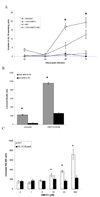Dithiocarbamates and viral IL-10 collaborate in the immortalization and evasion of immune response in EBV-infected human B lymphocytes
- PMID: 18163983
- PMCID: PMC2293282
- DOI: 10.1016/j.cbi.2007.11.005
Dithiocarbamates and viral IL-10 collaborate in the immortalization and evasion of immune response in EBV-infected human B lymphocytes
Abstract
Epstein-Barr virus (EBV) is implicated in the development of a number of human malignancies including several subtypes of non-Hodgkin lymphoma (NHL) [G. Pallesen, S.J. Hamilton-Dutoit, X. Zhou, The association of Epstein-Barr virus (EBV) with T cell lymphoproliferations and Hodgkin's disease: two new developments in the EBV Field, Adv. Cancer Res. 62 (1993) 179-239]. Lymphoproliferative disease and NHL occurring in severely immunosuppressed individuals almost always involve EBV and have been extensively studied and modeled in vitro. EBV has also been causally associated with some cases of NHL occurring in otherwise immunocompetent individuals. However, a direct role for EBV in the pathogenesis of neoplasms developing in the presence of an otherwise competent immune system has not been established. We investigated potential interactions between dithiocarbamates (DTC), an important class of thiono-sulfur compounds, and EBV leading to immortalization of human B lymphocytes and evasion of cell-mediated immune response in culture. Primary lymphocyte cultures employing wild-type and recombinant EBV mutants were used to assess the respective roles of DTC and viral genes in lymphocyte transformation and survival. Pretreatment of EBV-infected human B lymphocytes with DTC directly enhanced transformation in the absence of T cells (5 nM) and independently increased survival of transformed cells in the presence of competent autologous T cells (10 nM). Both DTC-induced transformation and immortalization of EBV-infected B lymphocytes were dependent on the expression of viral IL-10. These results provide a biological basis for studying collaborations between chemical and virus that alter lymphocyte biology, and provide a rationale for further molecular epidemiology studies to better understand the potential influence of these interactions on the development of NHL and perhaps other viral-associated malignancies.
Figures





Similar articles
-
Interleukin 15-mediated induction of cytotoxic effector cells capable of eliminating Epstein-Barr virus-transformed/immortalized lymphocytes in culture.J Natl Cancer Inst. 2001 Nov 21;93(22):1724-32. doi: 10.1093/jnci/93.22.1724. J Natl Cancer Inst. 2001. PMID: 11717333
-
Interactions involving cyclosporine A, interleukin-6, and Epstein-Barr virus lead to the promotion of B-cell lymphoproliferative disease.Leuk Lymphoma. 1996 May;21(5-6):379-90. doi: 10.3109/10428199609093435. Leuk Lymphoma. 1996. PMID: 9172802 Review.
-
Simultaneous detection of the two main proliferation driving EBV encoded proteins, EBNA-2 and LMP-1 in single B cells.J Immunol Methods. 2012 Nov 30;385(1-2):60-70. doi: 10.1016/j.jim.2012.08.008. Epub 2012 Aug 18. J Immunol Methods. 2012. PMID: 22921685
-
Induction of interferon-stimulated genes on the IL-4 response axis by Epstein-Barr virus infected human b cells; relevance to cellular transformation.PLoS One. 2013 May 27;8(5):e64868. doi: 10.1371/journal.pone.0064868. Print 2013. PLoS One. 2013. PMID: 23724103 Free PMC article.
-
EBV-NK cells interactions and lymphoproliferative disorders.Leuk Lymphoma. 1998 May;29(5-6):491-8. doi: 10.3109/10428199809050908. Leuk Lymphoma. 1998. PMID: 9643562 Review.
Cited by
-
Cytokine homologs of human gammaherpesviruses.J Interferon Cytokine Res. 2012 Feb;32(2):53-9. doi: 10.1089/jir.2011.0083. Epub 2011 Dec 5. J Interferon Cytokine Res. 2012. PMID: 22142220 Free PMC article. Review.
-
How Does Epstein-Barr Virus Interact With Other Microbiomes in EBV-Driven Cancers?Front Cell Infect Microbiol. 2022 Feb 23;12:852066. doi: 10.3389/fcimb.2022.852066. eCollection 2022. Front Cell Infect Microbiol. 2022. PMID: 35281433 Free PMC article. Review.
-
Sjögren's syndrome: a systemic autoimmune disease.Clin Exp Med. 2022 Feb;22(1):9-25. doi: 10.1007/s10238-021-00728-6. Epub 2021 Jun 7. Clin Exp Med. 2022. PMID: 34100160 Free PMC article. Review.
-
Benefits of Chimeric Antigen Receptor T-Cell Therapy for B-Cell Lymphoma.Front Genet. 2022 Jan 20;12:815679. doi: 10.3389/fgene.2021.815679. eCollection 2021. Front Genet. 2022. PMID: 35126471 Free PMC article.
-
Virus-encoded homologs of cellular interleukin-10 and their control of host immune function.J Virol. 2009 Oct;83(19):9618-29. doi: 10.1128/JVI.01098-09. Epub 2009 Jul 29. J Virol. 2009. PMID: 19640997 Free PMC article. Review. No abstract available.
References
-
- Pallesen G, Hamilton-Dutoit SJ, Zhou X. The Association of Epstein-Barr Virus (EBV) With T Cell Lymphoproliferations and Hodgkin's Disease: Two New Developments in the EBV Field. Adv. Cancer Res. 1993;62:179–239. - PubMed
-
- Thomas JA, Hotchin NA, Allday MJ, Amlot P, Rose M, Yacoub M, Crawford DH. Immunohistology of Epstein-Barr Virus-Associated Antigens in B Cell Disorders From Immunocompromised Individuals. Transplantation. 1990;49:944–953. - PubMed
-
- Thomas JA, Allday MJ, Crawford DH. Epstein-Barr virus-associated lymphoproliferative disorders in immunocompromised individuals. Adv. Cancer Res. 1991;57:329–380. - PubMed
-
- Caldwell RG, Wilson JB, Anderson SJ, Longnecker R. Epstein-Barr Virus Lmp2a Drives B Cell Development and Survival in the Absence of Normal B Cell Receptor Signals. Immunity. 1998;9:405–411. - PubMed
Publication types
MeSH terms
Substances
Grants and funding
LinkOut - more resources
Full Text Sources

